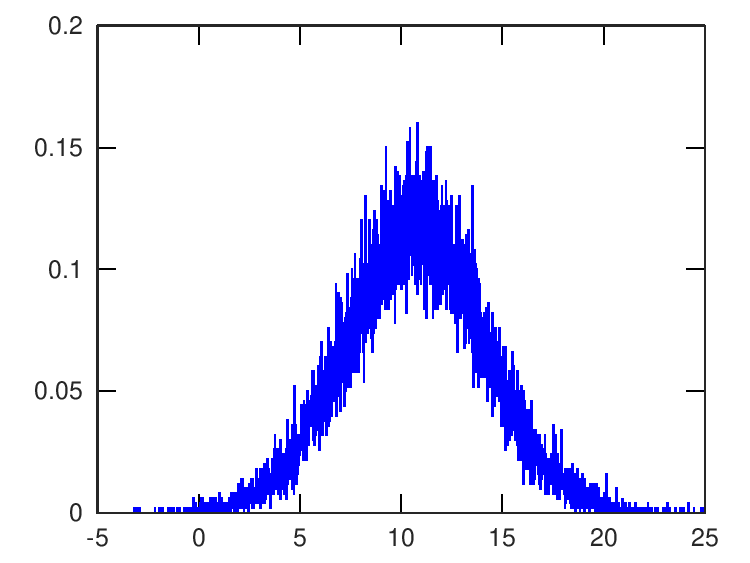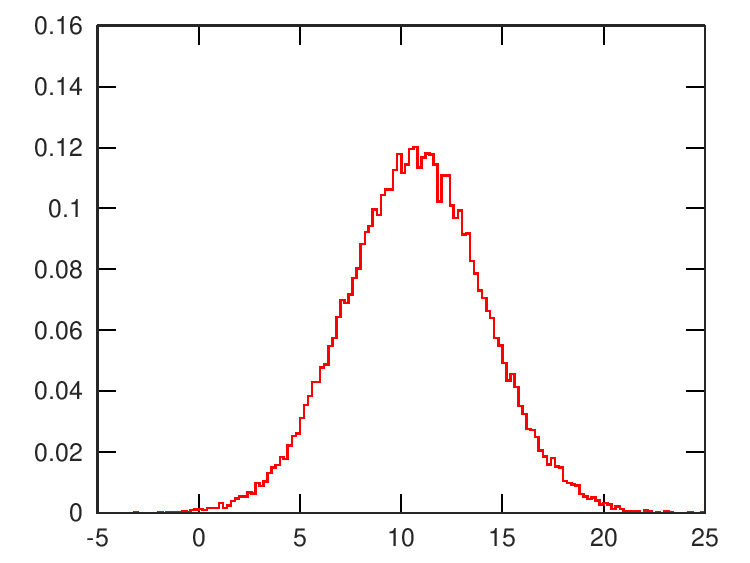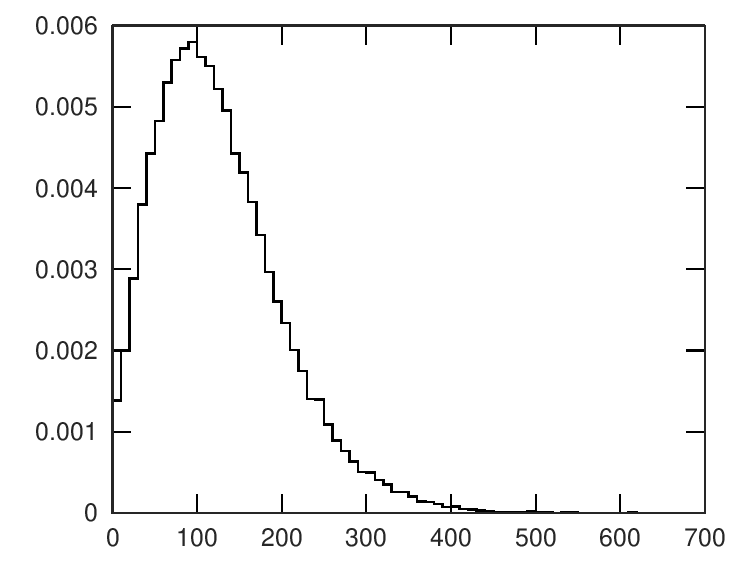Previous: parseOptions(), Up: General-Purpose Functions [Contents][Index]
HistHist is a Octave class which represents a multi-dimensional histogram.
It is useful for accumulating data of a statistical nature and determining its properties.
A one-dimensional histogram is created with the following command:
octave> hgrm = Hist(1, {"lin", "dbin", 0.01})
hgrm = {histogram: count=0, range=[NaN,NaN]}
This histogram will store data in bins with linear boundaries of width 0.01.
The Hist class can also store data in bins with logarithmic boundaries:
octave> Hist(1, {"log", "minrange", 0.02, "binsper10", 20})
ans = {histogram: count=0, range=[NaN,NaN]}
To add data to a histogram, use the addDataToHist() function.
Let’s add some Gaussian-distributed data:
octave> hgrm = addDataToHist(hgrm, normrnd(10.7, 3.42, [1e4, 1]))
hgrm = {histogram: count=10000, range=[-1.44,22.8]}
We can call addDataToHist() many time to add more data to the histogram:
octave> hgrm = addDataToHist(hgrm, normrnd(10.7, 3.42, [1e4, 1]))
hgrm = {histogram: count=20000, range=[-1.86,24.05]}
octave> hgrm = addDataToHist(hgrm, normrnd(10.7, 3.42, [1e4, 1]))
hgrm = {histogram: count=30000, range=[-2.05,24.05]}
octave> hgrm = addDataToHist(hgrm, normrnd(10.7, 3.42, [1e4, 1]))
hgrm = {histogram: count=40000, range=[-2.42,24.05]}
octave> hgrm = addDataToHist(hgrm, normrnd(10.7, 3.42, [1e4, 1]))
hgrm = {histogram: count=50000, range=[-2.42,24.05]}
We can now compute some basic statistical properties of the data, e.g.:
octave> meanOfHist(hgrm) ans = 10.730
octave> stdvOfHist(hgrm) ans = 3.3879
octave> arrayfun(@(x) cumulativeDistOfHist(hgrm, x), meanOfHist(hgrm) + (-2:2)*stdvOfHist(hgrm)) ans = 0.023173 0.157702 0.501401 0.841628 0.977569
octave> arrayfun(@(p) quantileFuncOfHist(hgrm, p), 0.5 + 0.5*[-0.95, -0.68, 0, 0.68, 0.95])
ans =
4.0630 7.3755 10.7183 14.0960 17.3700
octave> (ans - meanOfHist(hgrm)) / stdvOfHist(hgrm)
ans =
-1.9679992 -0.9902454 -0.0035522 0.9934369 1.9598407
The histogram can also be plotted:
octave> graphics_toolkit gnuplot
octave> plotHist(hgrm, "b");
ezprint("Hist-plot-1.png", "width", 180, "fontsize", 6);

The bin size can be changed by resampling the histogram to a coarser bin size:
octave> plotHist(resampleHist(hgrm, -5:0.2:25), "r");
octave> ezprint("Hist-plot-2.png", "width", 180, "fontsize", 6);

Histograms can be transformed by an arbitrary function. Here we plot the histogram of the squares of the samples:
octave> plotHist(resampleHist(transformHist(hgrm, @(x) x.^2), -10:10:650), "k");
octave> ezprint("Hist-plot-3.png", "width", 180, "fontsize", 6);

Further histogram functions are documented in the histograms and histograms/@Hist directories.
Previous: parseOptions(), Up: General-Purpose Functions [Contents][Index]